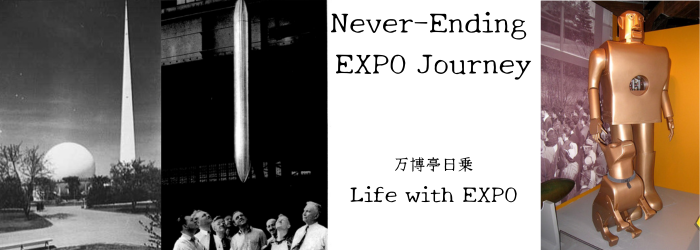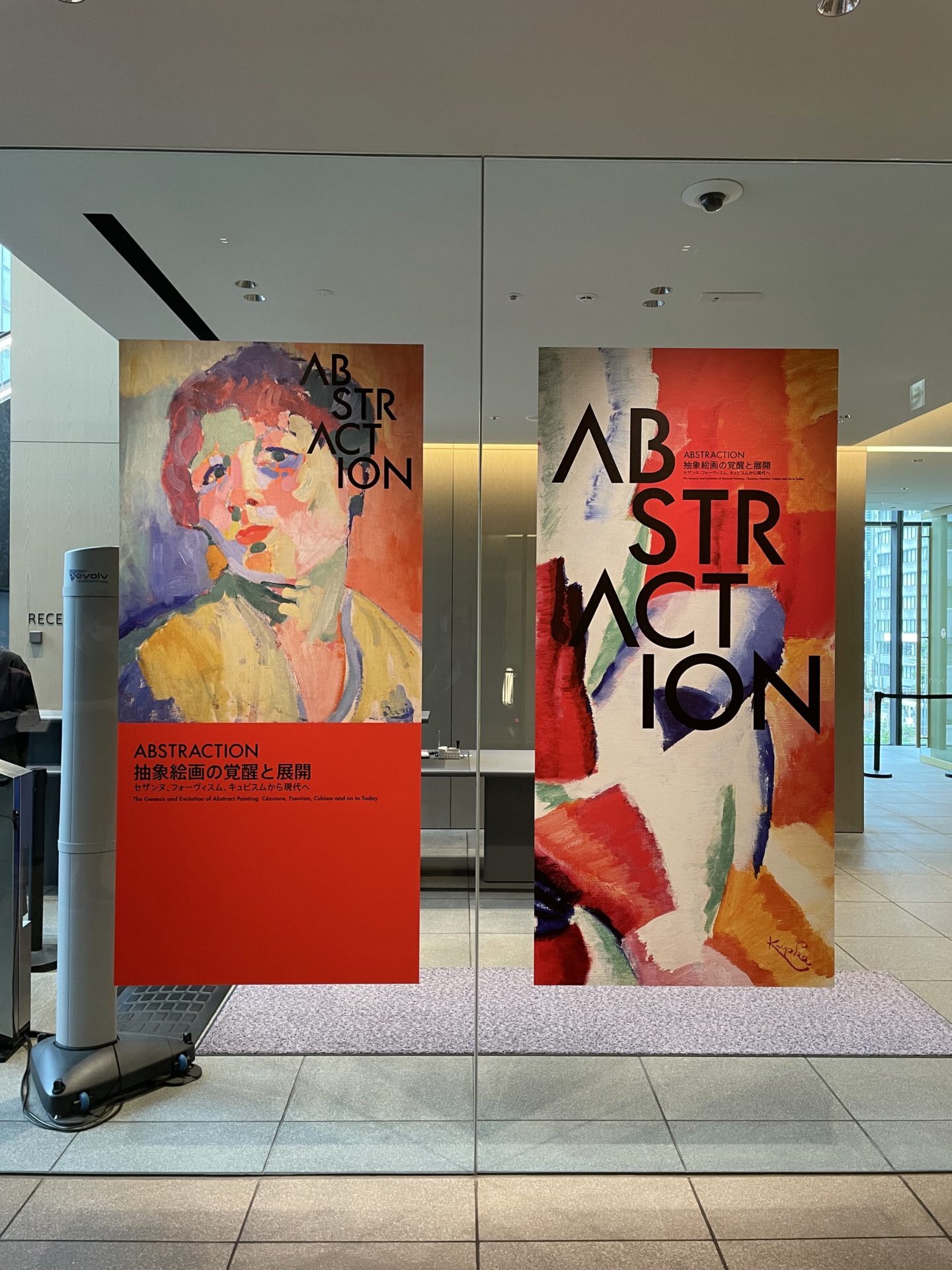ABSTRACTION The Genesis and Evolution of Abstract Painting, Cézanne, Fauvism, Cubism and on to Today
The author and Assistant No.0, No.2 went together to “ABSTRACTION The Genesis and Evolution of Abstract Painting, Cézanne, Fauvism, Cubism and on to Today”, which is being held from June 3rd to August 20th, 2023 at the Artizon Museum in Tokyo.
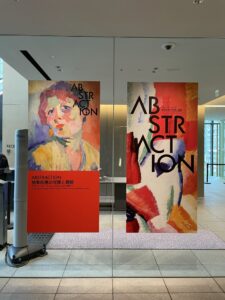
ABSTRACTION展 サイン
ABSTRACTION exhibition sign
Actually, I visited this exhibition in the beginning of July. This is over 3 weeks ago.
A lot of time has passed before this article is finished, as I was making some research and traced the relationship with the Expo to the details.
Lately, I’ve been busy in making research and writing stories.
Moreover, the contents of this exhibition are substantial, and the catalog for this exhibition is about 3 centimeters thick.
So, this time, I would like to divide the article into the first and the second part.
To the Artizon Museum
I visit this museum quite often.
It’s right on Yaesu Street from the Yaesu Exit of Tokyo Station, and it’s also close to Kyobashi Station and Nihonbashi Station. It’s located at a very convenient place to visit.
Every time I visit, I feel that the collection of this museum is very fulfilling. It houses many important works by various important artists.
Because of this, it might be possible to frequently hold spectacular special exhibitions.
This time, the theme is “ABSTRACTION“.
I visited with high expectations. Maybe we can also expect exhibitions related to World Expos (?).
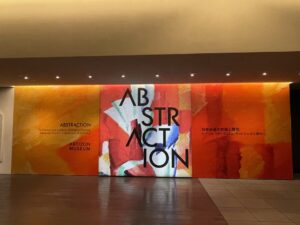
ABSTRACTION展 サイン
ABSTRACTION exhibition sign
Composition of the exhibition
This exhibition consists of the following 12 Sections.
Section 1 Origins of Abstract Art
Section 2 Fauvism and Cubism
Section 3 Genesis of Abstract Painting : Orphism, Futurism, Der Blaue Reiter,Blue, Bauhaus, De Stijl, and Abstraction-Création
Section 4 Roots and Branches of Abstract Painting in Japan
Section 5 Hot Abstraction and Lyrical Abstraction
Section 6 Trans-Atlantic : Pierre Matisse and His Surroundings
Section 7 Abstract Expressionism
Section 8 Evolution of Postwar Japanese Abstract Painting (to the 1960s)
Section 9 Gutai
Section 10 Takiguchi Shuzo and the Jikken Kobo (Experimental Workshop)
Section 11 Future Paths of Postwar Abstractions : Hans Hartung, Pierre Soulages, and Zhao Wou-Ki
Section 12 Contemporary Artists : Rita Ackermann, Anne Kagioka Rigoulet, Lou Zhenggang, Tsugami Miyuki, Shibata Toshio, Takabatake Yoriko, Yokomizo Miyuki
Section 1 Origins of Abstract Art
Section 1 displays works from the museum collection, including works by Paul Cézanne, Edouard Manet, Vincent van Gogh, Paul Gauguin, and Claude Monet. It is amazing that one section can be composed only of works in the museum’s collection. Each of these artists is also associated with Expos, as you may know from other article of this blog.
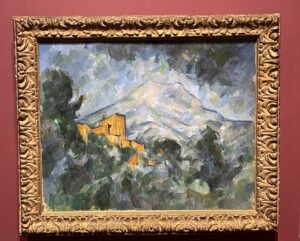
セザンヌ『サント=ヴィクトワール山とシャトー・ノワール
Cézanne “Mont Sainte-Victoire and Château Noir”
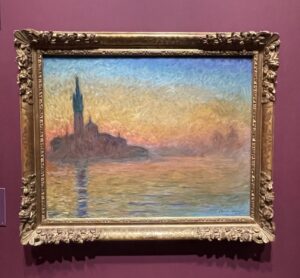
モネ『黄昏、ヴェネツィア』
Monet “Twilight, Venice”
Section 2 Fauvism and Cubism
Section 2 showcases works by Henri Matisse and others. One of them is “Collioure” (1905).
This title is similar to “Paysage de Collioure”(1905), which I mentioned in <26>“Matisse Exhibition” and Matisse’s works exhibited at the Expo.
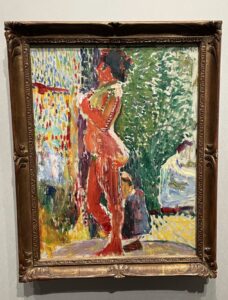
マティス『画室の裸婦』
Matisse “Nude in the Studio”
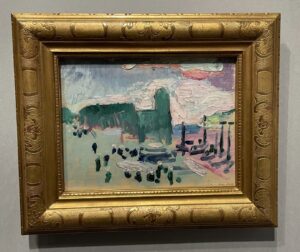
マティス『コリウール』
Matisse “Collioure”
The catalog this time says:
*
Collioure is a port town near the Spanish border in front of the Mediterranean Sea. From May to September 1905, Matisse stayed here with his friend Derain, a painter, and changed his painting style from pointillism to free coloration.
*
Therefore, there are several works with the name “Collioure” around 1905.
Investigation result of “Landscape of Collioure” (Menard Museum collection)
By the way, in Episode <26>, I investigated if “Landscapes of Collioure” (Menard collection), which is exhibited at the “Matisse Exhibition” currently being held at the Tokyo Metropolitan Art Museum, is the one which was exhibited at “Masters Exhibition” at the 1937 Paris Universal Exposition .
“Masters Exhibition” (“Masters of Independent Art 1895-1937 Exhibition“) is the exhibition which was held from June to October as part of the 1937 Paris Universal Exposition.
The old catalog of the “Masters Exhibition” states that “Landscapes of Collioure” belongs to the Collection Molyneux.
If the work of Menard Museum is the one which was exhibited at the “Masters Exhibition”, there should be a record that it used to be in the Collection Molyneux.
In fact, I had emailed the Menard Museum about this.
A person in charge at the Menard Museum kindly replied to me the other day.
The summary of what I received is as follows:
*
Concerning Matisse’s Landscape of Collioure, which is in the collection of the Menard Museum, it has not been confirmed by the current investigation that it was exhibited at the 1937 Paris Exposition or belonged to the Collection Molyneux.
*
Therefore, it can be said that the “Collioure Landscape” (Menard Museum collection) of the “Matisse Exhibition” currently being held at the Tokyo Metropolitan Art Museum is not the work exhibited at the 1937 Paris Universal Exposition.
I would like to express my deep gratitude to the person in charge of the Menard Museum for taking time out of their busy schedules to investigate this matter.
Pablo Picasso’s “Bust of Woman (Fernande Olivier)” (1909, private collection)
Now, let’s go back to the “ABSTRACTION” exhibition.
In addition to Matisse, Section 2 exhibits works by artists such as André Derain, Maurice Vlaminck, and Joan Miró.
Four works by Pablo Picasso (1881-1973) are also on display.
One of them, “Bust of Woman (Fernande Olivier)” (1909, private collection) is eye-catching.
The explanation of the catalog is as follows.
*
Fernando Olivier is Picasso’s representative model in his early period, and model for many of his works from 1907 to 1909.
*
About this Fernando Olivier, the English version of Wikipedia has as follows.
*
Olivier was Picasso’s first muse. In the spring and summer of 1906, following some sales of artwork, the couple were able to finance a trip to Barcelona and to the remote village of Gósol in the Spanish Pyrenees. In Barcelona Fernande was introduced to Picasso’s family and local friends. In Gósol Picasso worked prolifically including executing several portraits of Fernande. Later, among his most notable works of his Cubist period from 1907 to 1909, several were inspired by Olivier. These include Head of a Woman (Fernande).He later admitted that one of the “Demoiselles d’Avignon” was modeled after her. (Bold letters are by the author. Same below.)
*
“Demoiselles d’Avignon” (1907) is one of Picasso’s most famous works.
This work is said to depict five prostitutes in a brothel on Avignon Street in Barcelona.
This work is also a monumental work that is regarded as the beginning of Cubism.
Well, there are new discoveries (!?) about this work, and I would like to introduce it in detail in another episode soon.
Ossip Zadkine “Mother and Child”
There was also a work related to the World Expo by sculptor Ossip Zadkine (1890-1967).
The work on display this time is “Mother and Child”.
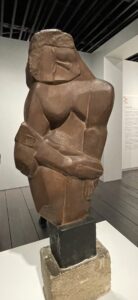
ザッキン『母子』
Zadkine “Mother and Child”
From the Artizon Museum, take Yaesu Street towards Tsukuda River City 21 and you will come across the Sumida River.
The Chuo Ohashi bridge spans over it.
Standing in the middle of the Chuo Ohashi bridge facing upstream is Ossip Zadkine’s “Messenger,” which is the same model exhibited at the 1937 Paris Universal Exposition.
Since “Messenger” is installed facing the upper reaches of the Sumida River, only its back can be seen from the Chuo Ohashi bridge.
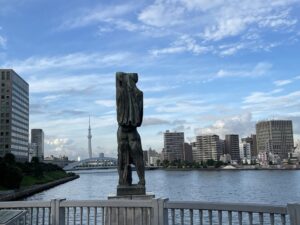
ザッキン『メッセンジャー』
Zadkin “Messenger”
According to the commentary board installed behind the statue, it is as follows.
*
According to the guidebook for the Paris Universal Exposition at the time, this work “represents the guardian deity of France who dispatches ships abroad in search of rare timber.” The “Messenger” embraces a ship reminiscent of the sailing ship depicted on the coat of arms of the city of Paris.
*
Paris is a sister city with Tokyo (since 1982), and the Seine is a friendship river with the Sumida (since 1989). In this connection, Jacques Chirac, who was the mayor of Paris at that time presented the statue to the Tokyo Metropolitan Government as a token of friendship.
By the way, Jacque Chirac was famous for his Japanophile and whose hobby was going to hot springs deep in the mountains of Japan, which even ordinary Japanese people do not know about.
Even now, the same Zadkine’s “Messenger” stands in the park on the left bank of the Seine river near the Les Invalides bridge in Paris.
And Ossip Zadkine exhibited his works at the 1937 Paris Exposition in addition to this “Messenger”.
It was the exhibition at “Masters Exhibition,” at the 1937 Paris Universal Exposition which was introduced in the Matisse episode (<26>).
According to the catalog of the “Masters of Independent Art 1895-1937 Exhibition”, Zadkine exhibited his works also at this exhibition as well.
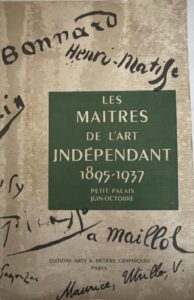
Catalog, Les Maitres de L’Art Indepéndant 1895-1937
Room number is 39. And he exhibited as many as 47 works.
They do not include “Messenger” or “Mother and Child” mentioned above.
According to the author’s research, “Messenger” was not exhibited at this “Masters Exhibition”, but at the “Forest Pavilion” (Le Pavillon des Bois).
Section 3 Genesis of Abstract Painting : Orphism, Futurism, Der Blaue Reiter,Blue, Bauhaus, De Stijl, and Abstraction-Création
In this section, exhibits related to the Bauhaus (1919-1933) are of particular interest.
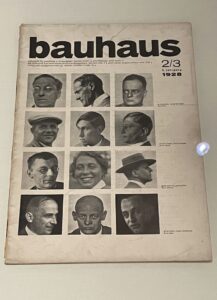
『バウハウス・ジャーナル』2巻、2/3号
“Bauhaus Journal”, vol.2, no.2/3
There are also works by Bauhaus-related artists such as Wassily Kandinsky and Paul Klee.
Paul Klee’s “Island”, that Mies van der Rohe (1886-1969), a famous architect who served as the third principal of the Bauhaus since 1930 and designed the “German Pavilion” at the 1929-30 Barcelona International Exposition, possessed before, was also exhibited.
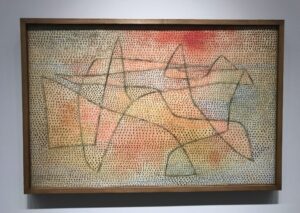
クレー『島』
Klee “Island”
(Continued to <33>)
